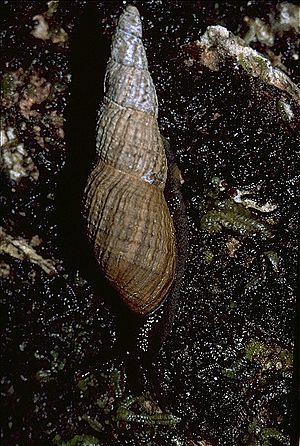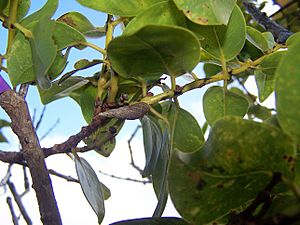Newcombia cumingi facts for kids
Quick facts for kids Newcombia cumingi |
|
|---|---|
 |
|
| Newcombia cumingi | |
| Conservation status | |
| Scientific classification | |
| Kingdom: | |
| Phylum: | |
| Class: | |
| (unranked): |
clade Heterobranchia
clade Euthyneura clade Panpulmonata clade Eupulmonata clade Stylommatophora clade Orthurethra |
| Superfamily: |
Achatinelloidea
|
| Family: |
Achatinellidae
|
| Subfamily: | |
| Genus: | |
| Species: |
N. cumingi
|
| Binomial name | |
| Newcombia cumingi Sykes, 1896
|
|
The Newcombia cumingi, also known as Newcomb's Tree Snail, is a special kind of land snail. It's a small mollusc that breathes air and lives on land. This snail belongs to the Achatinellidae family. You can only find this unique snail in Hawaii, United States.
Contents
Where Newcomb's Tree Snail Lives
The Newcomb's Tree Snail is the only known species of its kind on the island of Maui, Hawaii. However, six other similar Newcombia snails live on the island of Molokai. Today, this snail lives on private land that is part of the Puʻu Kukui Watershed Preserve.
Past and Present Locations
Long ago, these snails lived all over the West Maui Mountains. They were also found on the slopes of the Haleakalā volcano. People saw them at different heights, from about 300 meters (1,000 feet) to over 1,000 meters (3,280 feet) above sea level.
The last time anyone saw these snails was in the early 1900s. They were found near towns like Lahaina, Wailuku, and Makawao.
Rediscovery in 1994
In 1994, something exciting happened! People working to protect nature found a small group of Newcomb's Tree Snails. They were looking for plants that didn't belong in the West Maui Mountains. This discovery happened in the Puʻu Kukui Reserve.
This is the only place where these snails are known to live today. They are found on just one ridge on the northeastern side of West Maui. The area where they live is quite small, only about 2.5 hectares (6.18 acres). It's located between 735 meters (2,412 feet) and 805 meters (2,641 feet) high.
What Newcomb's Tree Snail Looks Like
The shell of the Newcomb's Tree Snail is special because it coils to the left. This is called "sinistral." Its shell is shaped like a long oval, a bit like a spindle.

Shell Features
The shell has five to seven twists, called whorls. These whorls have a rough surface. When fully grown, the snail's shell is about 2 centimeters (0.8 inches) long. The shell has shades of brown that help it blend in with the tree bark where it lives.
How Newcomb's Tree Snail Lives
Like other Hawaiian tree snails, the Newcomb's Tree Snail eats fungi and algae. These tiny plants grow on the leaves and trunks of native Hawaiian trees.
Growth and Reproduction
Scientists believe that Newcomb's Tree Snails grow very slowly. They also don't have many babies. It takes several years for an adult snail to be old enough to have young. The baby snails are born live, not from eggs. They usually stay on the same tree or bush where they were born.
These traits make the snails very sensitive. If something bad happens, like losing adult snails, it can be hard for the population to grow back. Newcomb's Tree Snails are often found on small Metrosideros polymorpha trees, also known as ohia lehua. They like areas with lots of ohia lehua trees and Dicranopteris linearis ferns.
Population Changes Over Time
In 1996, scientists started a study to count the snails. They marked snails and then tried to find them again later. They found 86 snails on three trees. From 1999 to 2002, they kept counting snails on these trees. The number of snails seemed to stay about the same.
But in 2006, things changed. Scientists went back to the marked trees. Two of the four study trees had died. They found many empty shells of a snail called the rosy carnivore snail. This snail is a predator. Sadly, they didn't find any living Newcomb's Tree Snails.
Later that year, more scientists searched the entire 2.5-hectare (6.18-acre) area. They found only nine living Newcomb's Tree Snails. This shows how much the population had shrunk.
Dangers to Newcomb's Tree Snail
The small area where Newcomb's Tree Snails live is protected as conservation land. However, the habitat is in bad shape. Many non-native plants are growing there and taking over.
Invasive Plants
Many of the small ohia lehua trees, which are important for the snails, have died. Even two trees that had marked snails on them are gone. Native ferns are being replaced by plants like blackberry, molasses grass, and Tibouchina. These invasive plants make it harder for the snails to find food and shelter.
Predators
Predation is a big problem for Hawaiian tree snails. Rats are a major threat to Newcomb's Tree Snails on Maui. Scientists found signs of rats eating other snails in the area. It's hard to find evidence of rats eating Newcomb's Tree Snails because their shells are small and fragile.
Other rats like the Norway rat and the Polynesian rat also eat Hawaiian tree snails.
Another dangerous predator is the rosy carnivore snail. This snail eats other snails. Scientists found many of these rosy carnivore snails living where Newcomb's Tree Snails are found.
Two other possible predators are a flatworm called Platydemus manokwari and another snail called Oxychilus alliarius. Both are known to eat snails. The flatworm likely lives on Maui too. Many shells of Oxychilus alliarius were found in the snail's habitat.
Protecting Newcomb's Tree Snail
Currently, Newcomb's Tree Snail does not have legal protection under Hawaii's endangered species law. However, the U.S. Fish and Wildlife Service has suggested listing it as an endangered species. This would give it more protection.
Captive Breeding Efforts
In 1995, five Newcomb's Tree Snails were taken to a special lab at the University of Hawaii. The goal was to breed them in captivity. In 2000, two more snails were added to help the group grow.
Even though the snails had babies in the lab, many of the newborns died. The population in captivity quickly went down. The last snail in captivity died on August 30, 2005. Right now, there are no Newcomb's Tree Snails living in captivity.
See also
 In Spanish: Newcombia cumingi para niños
In Spanish: Newcombia cumingi para niños


